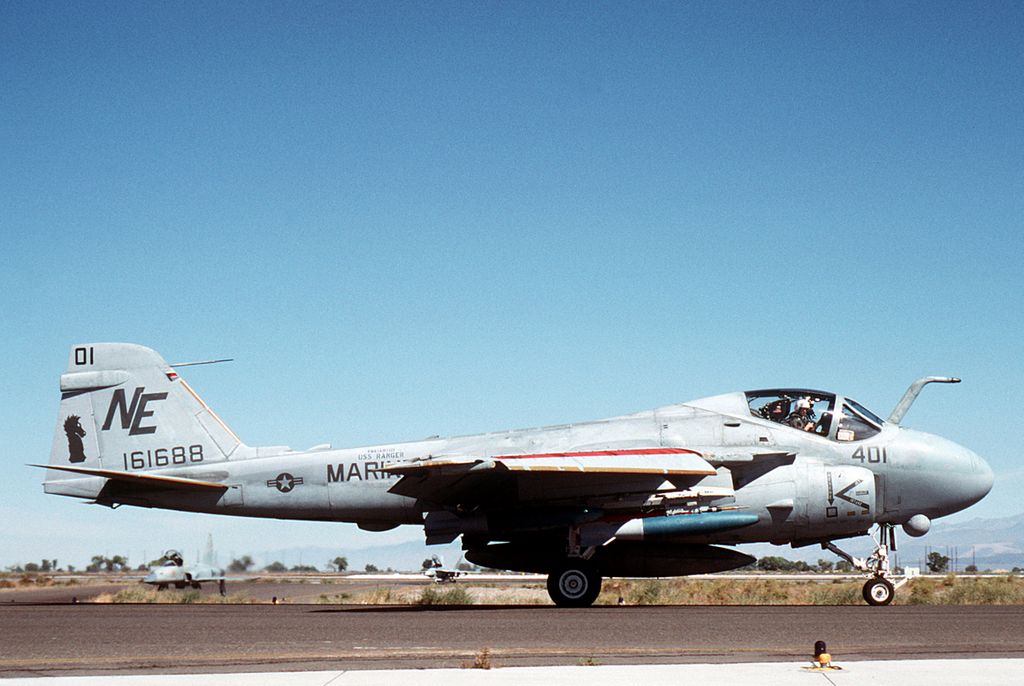“During Operation Desert Storm the B-52s heavily involved in CAS missions flew ten-hour missions from Diego Garcia. None had the external racks they used in Vietnam. They carried only 56 500-lb bombs. Two A-6s did more damage than a B-52” Capt Tom Uryga, former USMC A-6 pilot
During the Vietnam War, the Grumman A-6 Intruder served as the “Main Battery” of carrier aviation, and it was still in use by the US Navy and US Marine Corps (USMC) in 1996. The A-6 was still the most effective USMC strike aircraft during Operation Desert Storm (ODS) in 1991 because it was a true all-weather, day/night precision bomber.
Capt. Tom Uryga joined the VMA(AW)-224 “Bengals” in the early spring of 1990. He was an Eastern Washington University graduate. Uryga participated in the early ODS strikes as one of the USMC A-6 pilots;
`In the first part of the Gulf War, we started out with deep strikes on Basra, Shaibah, and Tallil. We’d use a mix [of ordnance], since the weather was shitty; 2000-lb LGBs and 2000-lb “steel nose cone”. We’d try to pickle the LGBs right in the middle of the basket. On the first night of the war we came back with better BDA [Bomb Damage Assessment] than the F-117s had.
`My first mission was with a guy named Rob McCarthy, an RAF Exchange officer, and Tornado navigator. He had absolutely no fear of death — he had flown in the airshow demo team for the Tornado where they do the 100-ft inverted near-supersonic pass. Nothing scared Rob.
`First night we flew, we’re heading into Iraq, and we’re heading into Shaibah airfield. This was the first time we had actually flown with the [navigation and formation] lights out and relied on the green formation lights instead – the lights on every jet were different. Some lights had burned out, which meant you couldn’t tell what was what. You thought you were rendezvousing on Battlestar Galactica because of all the different lights.
`Off to the left side, as we’re crossing the Gulf, you could see the SAM launches and AAA in Kuwait City – huge, holy shit, look at this stuff. Rob’s got his head in the boot, doing updates. We’re getting up there over the salt marshes, and little stuff – red tracers – was arcing below us, with bigger stuff, white tracers, reaching up higher to about 20,000 ft. Then you had some big AAA, big white bursts up at our altitude, but it was less frequent. I think the red stuff was ZSUs – it was disturbing enough, but you knew they weren’t all radar-guided because you didn’t have a lot of radar warning about everything.
`About this time Rob pulled his head out and said, in typical British fashion, “I say, Tom, it appears those blokes are shooting at us.” “No shit, Rob. Put your head back in the boot.”
After weeks of deep strikes and related operations, according to Rick Morgan’s description in his book A-6 Intruder Units 1974-96, on February 20 Marine units switched to Battlefield Air Interdiction (BAI) as their primary function in order to prepare for the ground assault. The employment of “Kill Boxes,” which were latitude and longitude grids where FACs, familiar with their assigned zone, would call in aircraft to target Iraqi army units as they were located, was crucial to the success of this mission. As the enemy forces realized they had little chance of escaping the Allied air force, the process proved lethally effective and contributed to their eventual mass capitulation.

During the last several days of Desert Storm, Capt. Uryga piloted a number of BAI sorties;
`The Air Force called the Kill Box missions CAS – what we Marines called CAS the Air Force called crazy!
`The B-52s [heavily involved in Kill Box operations] flew ten-hour missions from Diego Garcia. None had the external racks they used in Vietnam. They carried only 56 500-lb bombs. Two A-6s did more damage than a B-52. They just salvoed the entire load in one pass. Their BDA pictures showed mile-long strips of closely spaced craters, usually laterally displaced from their targets [largely due to 100-knot high-altitude winds]. Carpet-bombing made a lot of noise but didn’t hit much.
‘The typical Hornet load was four or six Mk 82s or Rockeyes. Without tankers, they had about ten minutes of time-on-station [TOS] in Kuwait. They made one pass, dropped two bombs, and then went feet wet to a tanker, gassed up, came in, and dropped the rest, before going home and getting credit for two combat missions on one flight. Pretty cheesy way to earn air medals. No [Marine] A-6 ever saw a tanker, yet we had more than 40 minutes TOS, even in northern Kuwait.’

The Intruder’s outstanding endurance made it a firm favorite amongst the Marines fighting the war on the ground. One FAC attached to the infantry was an EA-6B NFO, who stated post-war; `Our first three choices for CAS aircraft were, No 1, the Intruder, No 2, the Intruder, and No 3, the Intruder. It had plenty of bombs and enough gas to stick around. The Hornets had less of each, and as for the Harriers, if we didn’t have a target ready for them when they checked in they almost always went right back to the tanker.’
Photo by U.S. Marine Corps, U.S. Navy
A-6 Intruder Units 1974-96 is published by Osprey Publishing and is available to order here.

